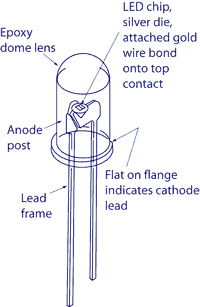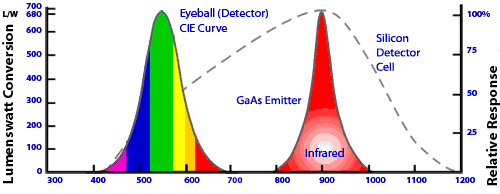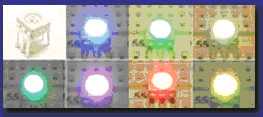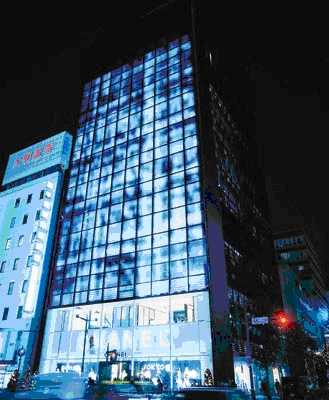|

Product Links 
|
|

Inside SRI

|
| SRI-Newsletter |
 |
Subscribe to our newsletter to receive monthly specials, manufacturer's feature, and electronics news via email. |
|
 |
|
See Our latest release of SRI-Newsletter here
 |
|
View Our List of Archived Newsletter Articles
 |
|

SRI Links

|
|
Visit our Sister Site,

Distributor of
Industrial Products
| |
|
Web Search ..
Powered by;

|
|
 |
 |
 |
 |
 |
|
LED technology is growing in leaps and bounds - similar to that of computers and the Internet. In the 1980's when a new material, GaAlAs (gallium aluminum arsenide) was developed, the rapid growth in the use of LED's began to occur. LED's were designed for applications such as bar code scanners, fiber optic data transmission systems, medical equipment, and more recently for flashlights, traffic signals, and car instruments. Not only has brightness and efficiency increased, but also the variety of colors and styles.
A light-emitting diode (LED) is a semiconductor device that emits incoherent monochromatic light when electrically biased in the forward direction.1 Nick Holonyak Jr. developed the first practical visible-spectrum LED in 1962.1 An LED is a special type of semiconductor diode. Like a normal diode where electricity can only flow in one direction, it consists of a semiconducting material with impurities to create a structure called a pn junction. Electrons and holes (spaces for electrons) flow into the junction from electrodes with different voltages. When an electron meets a hole, it falls into a lower energy level and releases a photon. The color (or wavelength) of light depends on the material that makes up the pn junction.
| 
|
LED's have come a long way since the 1960's. The first commercial LED's were only able to produce invisible, infrared light, but still quickly found their way into sensing and photoelectric applications. The use of Gallium Aluminum Arsenide Phosphide (GaAlAsP) in the early to mid 1980's brought the first generation of superbright LED's, first in red, then yellow and finally green. By the early 1990's ultrabright LED's using Indium Gallium Aluminum Phosphide (InGaAlP) to produce orange-red, orange, yellow and green light had become available.3

The human eye is not as sensitive to red light as it is for yellow or green. Red LED's have limited potential because of this. Although a green and red LED might emit the same amount of light, the green LED will appear much brighter. This is one reason that technology had to be improved especially for outdoor applications.
The ultrabright blue chips became the basis of white LED's, in which the light-emitting chip is coated with fluorescent phosphors. These phosphors absorb the blue light from the chip and then re-emit it as white light. This same technique has been used to produce virtually any color of visible light and today there are LED's on the market which can produce previously "exotic" colors, such as aqua and pink. Now RGB LED's are available.

Kingbright LEDs
 > >
Paul Gregory of Focus Lighting worked with David Rockwell on FAO Schwarz's renovation, which features a ceiling with 80,000 LED's that can be programmed into different patterns
RGB fluorescent has traditionally been the source behind color-changing effects, and is still being used very successfully on certain projects. More designers like Darren Nolan, an architect with Peter Marino + Associates, which recently completed an eight-story building for Chanel in Tokyo, turned to LED's to illuminate its façade.4

|
Chanel's new Tokyo headquarters, designed by Peter Marino, has a triple-glazed facade featuring view-controlled glass and LED's that enable the building to be completely transparent by day and lanternlike at night. The building has art director who programs different patterns for the facade.
Courtesy Peter Marino & Associates |
|
The main advantage is the low-maintenance, but there are several other advantages over conventional lighting. Since they do not radiate heat, LED's work well in environments where heat may damage the object being illuminated-art or chocolate, for example. Current white LED's will last up to 50,000 hours, about 50 times as long as a 60-watt bulb. That's almost six years if they're on constantly. Being solid-state, they can resist the vibrations in aircraft and cars. Instead of a dimmer like an incandescent lamp might use, an LED light could make use of a knob that adjusts the color of light in a house.
1) http://search.localcolorart.com/search/encyclopedia/Light-emitting_diode/
2) http://www.ledproductstore.com/history_of_led_technology.htm
3) http://www.wavicle.biz/led_history.html
4) http://www.archpaper.com/feature_articles/05_05_bright_lights.html
|
|
**Specifications subject to changes**
|
|
 |
|

Product Spotlight
 |
|

Sponsored Ads
 |
|